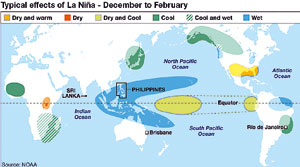It was News Time on TV. Both Puncha and Panchi were surprised by seeing the footage of an elephant on top of a tree, killed by floods. “Look at the poor
elephant on the tree Aiya.. How did his body go up that high..?” Panchi was puzzled.
“The floods had taken his body that high,” Puncha reminded his
sister about the recent bad rains.
“But why so much rains at this time..?” Panchi wanted to know.. “La Niña,” Puncha proudly shouted what he had seen on TV earlier. “La… WHAT…??”
Little Panchi didn’t know what it was. “La Niña, – this is something that happened in the Pacific Ocean which brought heavy rains to Sri Lanka.”
“But Aiya the Pacific Ocean is far away from Sri Lanka isn’t it?” said Panchi and ran to the inflated globe on their study table. “See – it is so far from Sri Lanka.”“Hmm.. Can’t be…
Is it..? But… (oops)” Puncha too got stuck
realizing the Pacific Ocean was indeed far away from Sri Lanka.
Luckily, Seeya was around… Seeya is the wiseman both kids
trust when they have a question. They ran to Seeya with the globe…
Folding the newspaper he was reading, Seeya started to explain. “La Niña is a phenomena where the sea surface
temperature of the Eastern Central Pacific Ocean near the
equator drops by about 3 to 5 degrees Celsius. When the ocean is cooler than normal, it disturbs the normal wind pattern which brings rains to different parts of the world including
Sri Lanka”.
“The region of Earth receiving the sun's direct rays is the tropics, which are close to the equator. Here, air is heated and rises, leaving low
pressure areas behind. To fill these low presure areas, cooler air starts flowing in from other areas. This creates wind
patterns.”
“Wind patterns…??” Panchi was confused. “Can you remember what happens when Amma burns leaf
litter in the garden..? Have you noticed that
sometimes ash and
particles of burnt leaves also rise with the fire..? This happens because the air heated by the fire goes up. To fill this void, air from surrounding areas
flows in – this forms a wind.”
“These winds that sweep across the oceans, bring lots of water vapour. When this water vapour condenses, it comes down as rain.
Changes in sea
temperature on one side means there are more variations between these
pressure areas, so the atmosphere has more energy than normal which can bring heavier rains to some parts and cause droughts in other instances”.
It was a lengthy
explanation Seeya gave about La Niña. “Hmm.. What is then El Niño, Seeya?” Puncha also remembered
something he heard
earlier. “Well, El Niño is the complete opposite of
La Niña. La Niña is due to cooler currents, while
El Niño is caused by a warm oceanic current in the Pacific Ocean near the equator”, explained Seeya.
“So do El Niño and
La Niña occur due to climate change caused by global warming..??” Puncha wanted to know.
Seeya scratched his head… “Hmm.. These kind of events have
happened in the earth in the past too, but
scientists believe that due to global warming, the power of these rains have increased and they occur more often than in the past.”
“The planet is warming because we do activities that emit more gases like carbon dioxide that trap the Sun's heat …”“We too can help by switching off unnecessary lights etc,” Panchi said repeating what she was advised by Seeya in the past. “Hey – Nangi.. Look who is talking.. You left the TV switched on and nobody is watching it..” Puncha said jokingly.
“It wasn’t I who switched it on.. It was you.. So you have to switch it off..” Panchi declared. “Hey kids.. There is no use fighting about whose job it is… Let’s switch it
off and any other
electrical items when we are not using them, in order to do our part to fight against Global Warming”, said Seeya while taking the remote control to switch the TV off.
Tell your friends
Do you know how to properly pronounce
La Niña..?
La Niña is a Spanish word, so pronunciation is different. It is difficult to write here, but it should be pronounced as
\lä-nē-nya\.
The name La Niña originates from Spanish, meaning "girl child", analogous to El Niño meaning "boy child". |


